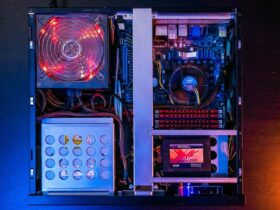As a computer user, you may have wondered, “Why is my GPU so hot?” A hot GPU can lead to performance issues, instability, and even hardware damage if addressed. Whether you’re a gamer pushing your graphics card to the limits or a casual user experiencing unusual heat, understanding the causes and solutions behind GPU overheating is crucial. In this article, we’ll explore the various factors that contribute to a hot GPU and provide you with practical solutions to keep your graphics card running, calm, and efficient.
Why Is My GPU So Hot?
Your GPU may be running hot due to several reasons. First, demanding tasks like gaming or rendering can generate much heat. Ventilation, dust buildup, and an adequately designed case can exacerbate the issue. Overclocking your GPU can also raise temperatures significantly. Additionally, outdated or malfunctioning drivers, as well as resource-intensive background processes, can contribute to overheating. To address this, ensure proper cooling, clean your system regularly, avoid excessive overclocking, and keep your drivers up to date. Monitoring your GPU’s temperature and identifying the cause can help you take appropriate measures to keep it running at optimal temperatures.
The Common Reasons For A Hot GPU
There are several common reasons why a GPU (Graphics Processing Unit) might run hot:
Intensive Graphics Workloads: One of the primary reasons for a hot GPU is running intensive graphics workloads. Tasks like modern gaming, 3D rendering, or complex simulations require the GPU to work at maximum capacity. As the GPU works harder, it generates more heat, which can cause its temperature to rise significantly.
Poor Ventilation and Airflow: Adequate airflow and ventilation are crucial for keeping a GPU cool. If your computer case has limited airflow or poorly designed ventilation, hot air can get trapped inside, raising the GPU’s temperature. Factors like a crowded case with cables obstructing airflow, or inadequate fan placement, can contribute to this problem.
Dust and Debris Accumulation: Over time, dust and debris can accumulate on your GPU’s heatsink and fans. This accumulation acts as an insulator, preventing efficient heat dissipation. As a result, the GPU has to work harder to maintain safe temperatures, causing it to run hotter than it should.
Overclocking: Many users overclock their GPUs to extract more performance from them. While overclocking can provide a noticeable performance boost, it also increases power consumption and generates more heat. If not done carefully and with the appropriate cooling solutions, it can lead to overheating and potential damage to the GPU.
Aging Hardware: As GPUs age, their thermal performance may degrade. The thermal paste that helps transfer heat from the GPU die to the heatsink can dry up and lose its effectiveness. This can result in reduced heat dissipation and higher temperatures. Additionally, older GPUs may have worn-out or less efficient cooling components, making them more susceptible to overheating.
Software-Related Causes
Software-related causes can also contribute to a hot GPU. Here are some key factors to consider:
- Outdated or corrupted graphics card drivers can lead to inefficient GPU performance and increased heat generation. It’s essential to keep your GPU drivers updated to ensure they are optimized for your system’s stability and cooling.
- Sometimes, conflicts between different driver versions or conflicting software can cause your GPU to work harder than necessary, leading to higher temperatures. Resolving driver conflicts and ensuring that your system software is well-maintained can mitigate this issue.
- Resource-intensive background processes and software running on your computer can put an additional load on your GPU, causing it to heat up unnecessarily. This can include applications like cryptocurrency mining software, video streaming, or even malware that exploits your GPU for its operations. Identifying and terminating such processes can help reduce GPU heat.
- Some applications or games need to be optimized to use your GPU’s resources efficiently. As a result, the GPU may run at high utilization levels even when unnecessary, leading to increased heat production. Adjusting in-game graphics settings or using frame limiters can help mitigate this problem.
- Using overclocking software that isn’t configured correctly can lead to overheating issues. If you’ve used overclocking software to boost your GPU’s performance, ensure that the settings are stable and that the additional power and heat generation are within safe limits.
What Are The Solutions Of GPU Are So Hot?
Addressing an overheating GPU requires a systematic approach considering hardware and software factors. Here are detailed solutions to combat a hot GPU:
Proper Case and Cooling System Setup:
Ensure that your computer case has adequate ventilation and airflow. Choose a case with sufficient fan mounts and install fans strategically for efficient air circulation. Proper cable management can also reduce airflow obstructions. Consider adding aftermarket cooling solutions like more giant fans or advanced heat sinks if necessary.
Regular Maintenance:
Routine maintenance prevents dust and debris buildup, hindering cooling performance. Clean your GPU’s heatsink and fans regularly to remove accumulated dust. Additionally, consider reapplying thermal paste to the GPU if you notice temperature issues due to aging hardware.
Adjust Graphics Settings:
If you’re experiencing overheating during gaming or graphics-intensive tasks, adjust in-game graphics settings to lower the workload on your GPU. Reducing settings like resolution, texture quality, and anti-aliasing can significantly decrease heat generation while providing an enjoyable gaming experience.
Avoid Overclocking:
While overclocking can boost GPU performance, it also generates more heat. If you’ve overclocked your GPU, consider dialing back the settings to the default or safer levels to reduce heat production. Ensure that your GPU’s overclocking settings are stable and within recommended limits.
Update Drivers:
Keep your graphics card drivers up to date. Manufacturers often release driver updates that include performance optimizations and fixes for known issues. Updated drivers can help improve GPU efficiency and reduce heat generation.
Monitor and Diagnose:
Utilize GPU monitoring tools and software to monitor your GPU’s temperature and usage. Diagnostics and stress tests can help identify the specific cause of overheating, allowing you to take appropriate measures.
Advanced Cooling Solutions
Advanced cooling solutions are essential for maintaining optimal temperatures and performance in high-end systems or scenarios where standard cooling methods may fall short. These solutions are designed to effectively dissipate heat generated by powerful components like CPUs and GPUs. Here are some advanced cooling solutions:
Liquid cooling systems consist of a pump, a radiator, and liquid-filled tubes. These systems are highly efficient at dissipating heat, especially in overclocked systems or for CPUs and GPUs with high thermal output. All-in-One (AIO) coolers are pre-assembled liquid cooling solutions that are easier to install than custom loop setups.
Enthusiasts and overclockers often opt for custom loop liquid cooling. This involves creating a custom cooling system with water blocks, radiators, pumps, and reservoirs. Custom loops offer superior cooling performance but require more expertise to set up and maintain.
Phase-change cooling systems use a refrigeration cycle to cool components. These systems are incredibly efficient but are typically expensive and complex, making them suitable for extreme overclocking and industrial applications.
TEC modules, known as Peltier coolers, use a semiconductor-based technology to transfer heat away from components. They can be combined with traditional cooling methods to achieve lower temperatures, but they require careful management to prevent condensation.
High-Performance Air Coolers: High-end air coolers feature large heatsinks and multiple heat pipes to dissipate heat effectively. These coolers are often quieter than liquid cooling solutions but may provide a different level of cooling performance in extreme scenarios.
Sub-ambient cooling methods, such as phase-change or LN2 (liquid nitrogen), can achieve temperatures below room temperature. These methods are primarily used in competitive overclocking for record-setting purposes.
Bottom Line
A hot GPU can lead to performance problems and potential damage if addressed. To resolve this issue, you should focus on maintaining proper cooling and ventilation, conducting routine maintenance, adjusting graphics settings, and avoiding aggressive overclocking. Keep a close eye on your GPU’s temperature and identify specific causes to implement targeted solutions. By taking these steps, you can ensure your GPU operates at safe temperatures, preserving its longevity and performance.
FAQ’s
Q: What is the ideal GPU temperature range?
A: The ideal GPU temperature range depends on the specific graphics card and its manufacturer, but generally, temperatures below 80-85 degrees Celsius under load are considered safe.
Q: How can I monitor my GPU’s temperature?
A: You can monitor GPU temperature using software tools like MSI Afterburner, GPU-Z, or the built-in monitoring features of many graphics card drivers.
Q: What can I do to prevent GPU overheating?
A: To prevent GPU overheating, ensure proper case and cooling system setup, perform regular maintenance to clean dust and debris, adjust graphics settings, avoid aggressive overclocking, and monitor your GPU’s temperature.
Q: Is overclocking safe for my GPU?
A: Overclocking can boost GPU performance but may lead to increased heat generation. Safe overclocking practices involve gradual increases in clock speeds while monitoring temperature. Be cautious not to push your GPU beyond its limits.























Leave a Reply